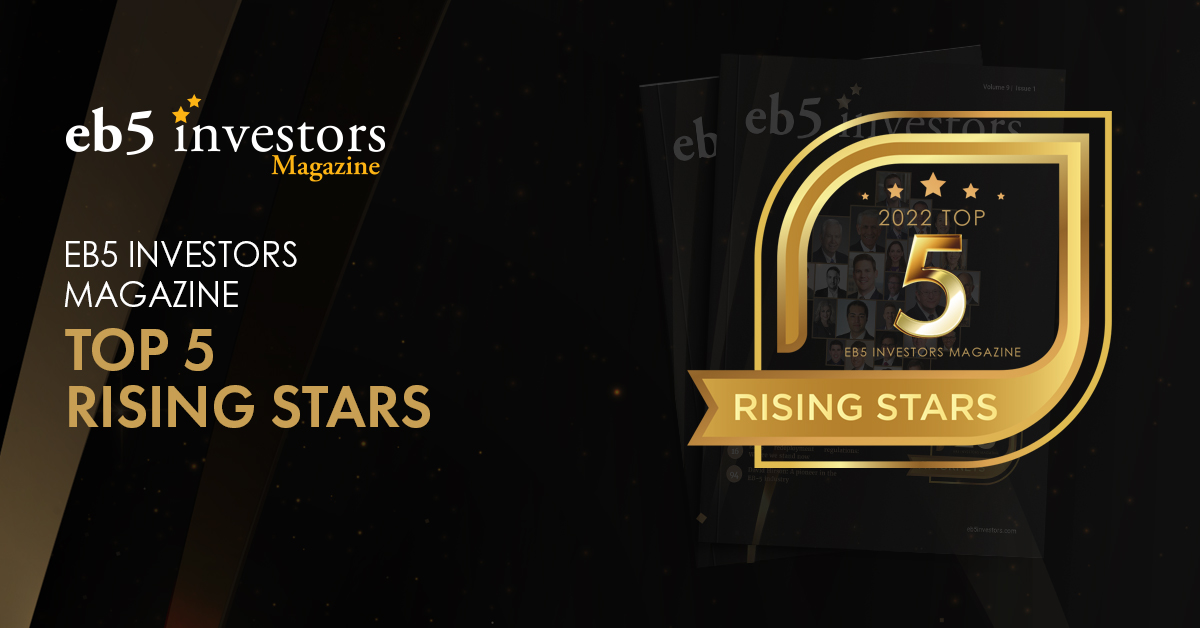
EB5 Investors Magazine is pleased to announce the Top 5 Rising Stars in the EB-5 industry. To be eligible, distinguished attorneys needed to be increasing their footprint in the EB-5 industry.
For more information or to contact any of these professionals, we invite you to view their listings at www.EB5Investors.com/directories.
MARJAN KASRA
Lawmaks
 Marjan Kasra is the founder and managing attorney of Lawmaks with offices in New York, Stamford, Dubai and Istanbul, where she and her team of experts specialize in EB-5 practice, with a focus in the MENA region. Lawmaks provides creative solutions to individuals and corporations, in helping them navigate through the complex issues they face with U.S. immigration. Kasra is a board member in IABA’s NY Chapter, an active member of AILA, and a committee member of New York City Bar’s MENA committee. She is a frequent speaker on Immigration venues related to investment visa categories.
Marjan Kasra is the founder and managing attorney of Lawmaks with offices in New York, Stamford, Dubai and Istanbul, where she and her team of experts specialize in EB-5 practice, with a focus in the MENA region. Lawmaks provides creative solutions to individuals and corporations, in helping them navigate through the complex issues they face with U.S. immigration. Kasra is a board member in IABA’s NY Chapter, an active member of AILA, and a committee member of New York City Bar’s MENA committee. She is a frequent speaker on Immigration venues related to investment visa categories.
What trends are you experiencing following the EB-5 reauthorization?
The changes in the March 15, 2022 reauthorization program have left EB-5 investors and RCs alike in a “limbo” state. As a result, we are seeing an uptick in interest for the direct EB-5 program, which has proven to be more “stable.” Another trend is with potential investors exploring other options such as L-1 or E-2 visa categories which may, under certain circumstances, allow the investor to apply for adjustment of status, with either an increased investment, or with utilizing EB1-C as the basis. While more complex, said alternatives may serve as viable alternatives for the right investor.
How do you think the pandemic has impacted the EB-5 industry?
With COVID-19 impacting the global markets, many viable pre-COVID investors are no longer in a position to invest the required sum in order to gain U.S. residency through the EB-5 program. That said, majority of foreign investors still believe United States to be a much safer bet due to instability in their own markets, and deficiencies in their government’s response to COVID-19. With the investors shaking off the negative effects of the pandemic, we are seeing a renewed interest, and a more resolved attitude toward immigration to the U.S., with the hope to reach safer grounds.
RAFAEL LAMBERTI
Reinhardt LLP
 Rafael Lamberti is a partner at Reinhardt Savic Foley LLP. Lamberti represents both individual and corporate clients on a wide variety of immigration matters by advising them on all phases of nonimmigrant visa petitions and applications for permanent residency and citizenship. He has substantial knowledge and expertise in employment and investment based nonimmigrant visas. With regard to EB-5 visas, he has advised clients in structuring direct and pooled investments, as well as investments in various regional centers. Lamberti was born and raised in Sao Paulo, Brazil, and he began his life in the United States as an immigrant like many of his clients today.
Rafael Lamberti is a partner at Reinhardt Savic Foley LLP. Lamberti represents both individual and corporate clients on a wide variety of immigration matters by advising them on all phases of nonimmigrant visa petitions and applications for permanent residency and citizenship. He has substantial knowledge and expertise in employment and investment based nonimmigrant visas. With regard to EB-5 visas, he has advised clients in structuring direct and pooled investments, as well as investments in various regional centers. Lamberti was born and raised in Sao Paulo, Brazil, and he began his life in the United States as an immigrant like many of his clients today.
What trends are you experiencing following the EB-5 reauthorization?
With regard to EB-5 projects, we have seen a noticeable change in what kinds of new projects are being structured with more emphasis on rural areas that did not see as much investment as real estate developments, for example. Because of the higher amounts, we see that projects are offering better financial returns to investors. As for the investors themselves, we have seen a lot of clients take advantage of the ability to now concurrently file the adjustment of status application while the I-526 is still pending. This is a significant change since I-526 processing times are still very high, but at least investors and their families can now wait for their approvals in the United States.
How do you think the pandemic has impacted the EB-5 industry?
The pandemic and the subsequent shutdown had a significant impact on several EB-5 projects, however, this impact did not trickle down to investors and their petitions. Since many EB-5 projects were either large real estate developments and/or hospitality properties, the shutdowns and limitations on travel substantially impacted the operations in these two industries. For EB-5 projects that were reliant on on-going operations to sustain their business model, financial projections, and job creations, this impact was devastating. It potentially impacted the viability of the green card applications attached to it, but many other projects already had the jobs created prior to the pandemic, so the impacts were limited to their financial performances.
PHUONG LE
KLD LLP
 Phuong Le is a founding member and partner with KLD LLP. He has over 15 years of experience and helps lead a global EB-5 practice group. He draws upon an extensive background advising parties on all sides of EB-5 transactions, including regional centers and direct EB-5 investments, project developers, agents, and investors. His clients span the globe and he has advised on over 5,000 investor petitions and over $2.5 billion in EB-5 financing for projects across the U.S., including commercial real estate, multifamily, charter schools, hotels, and publicly-traded franchises. He frequently travels and shares his knowledge regarding complex EB-5 matters as a lecturer, author, and EB-5 expert witness for other firms and the EB-5 industry.
Phuong Le is a founding member and partner with KLD LLP. He has over 15 years of experience and helps lead a global EB-5 practice group. He draws upon an extensive background advising parties on all sides of EB-5 transactions, including regional centers and direct EB-5 investments, project developers, agents, and investors. His clients span the globe and he has advised on over 5,000 investor petitions and over $2.5 billion in EB-5 financing for projects across the U.S., including commercial real estate, multifamily, charter schools, hotels, and publicly-traded franchises. He frequently travels and shares his knowledge regarding complex EB-5 matters as a lecturer, author, and EB-5 expert witness for other firms and the EB-5 industry.
What trends are you experiencing following the EB-5 reauthorization?
I think there is a clear demand from projects that are able to harness the benefits of the new rules to speed up processing for investors – whether that’s being in a rural area, to specially qualified for expedited processing, etc. For all its benefits, the biggest headache families have had is the lack of predictable processing times that prevent them from being able to plan when they can enter the U.S., buy property, and enroll their kids in school. That’s why these projects will be in demand pre-investment and post-investment, people are definitely seeing mandamus as an effective and necessary option to push their case through the logjam.
How do you think the pandemic has impacted the EB-5 industry?
COVID has certainly affected the industry, in both negative and positive ways. It mostly has changed how people view risk. From a negative viewpoint, we see certain asset classes that were hugely popular before all but lose their support overnight, namely food & beverage and hotels. People are understandably wary about how these businesses will do if there’s another pandemic and are hesitant about investing in them. On the flipside, COVID has also shown how the industry will adapt – webinars are now a routine marketing tool and effectively supplement the big in-person seminars – and COVID has also driven EB-5 demand because lockdowns have made people realize no matter how wealthy you are, there’s only so much freedom and mobility you have in your country if there’s another shutdown. Thus, despite EB-5’s increased price, we also see more demand.
ANIBAL SANCHEZ
Darren Silver & Associates
 Anibal Sanchez is a partner at Darren Silver & Associates, LLP and has exclusively practiced immigration law throughout his legal career. As the managing partner of the firm’s EB-5 practice, he has worked with thousands of individual EB-5 investors. He has counseled many regional centers and U.S. businesses on EB-5 related issues. Sanchez also represents a wide variety of businesses and works with entrepreneurs, foreign executives, and highly skilled workers in all business-related immigration matters. A member of AILA, Sanchez is certified by the State Bar of California, Board of Legal Specialization as a specialist in immigration and nationality law.
Anibal Sanchez is a partner at Darren Silver & Associates, LLP and has exclusively practiced immigration law throughout his legal career. As the managing partner of the firm’s EB-5 practice, he has worked with thousands of individual EB-5 investors. He has counseled many regional centers and U.S. businesses on EB-5 related issues. Sanchez also represents a wide variety of businesses and works with entrepreneurs, foreign executives, and highly skilled workers in all business-related immigration matters. A member of AILA, Sanchez is certified by the State Bar of California, Board of Legal Specialization as a specialist in immigration and nationality law.
What trends are you experiencing following the EB-5 reauthorization?
The diversity of clients interested in pursuing EB-5 has increased dramatically. Our practice has received inquiries from clients from all over the world – even China given the glimmer of hope provided by the rural TEA set aside. It appears as if demand for EB-5 increased during the lapse in the program, and once the minimum investment threshold was codified at $800,000, many prospective investors reached out to inquire on the process. The interest has been strong for both investors who are focused on regional center associated projects and investors who are interested in direct projects.
How do you think the pandemic has impacted the EB-5 industry?
The pandemic clearly slowed demand from investors for EB-5 visas. It immediately followed the later overturned regulations increasing the minimum investment amount to $900,000. These two factors slowed investor interest in 2020 to a crawl compared to prior years. This lack of investor demand and other economic factors caused by the pandemic will likely impact the number of project operators interested in taking projects to market. Those regional centers and project operators who are well-established and able to weather the storm of the past two years will be well-positioned to meet new investor demand moving forward.
DENNIS TRISTANI
Tristani Law
 Dennis Tristani is the managing attorney at Tristani Law, LLC. His primary areas of concentration include U.S. immigration petition filings for investors, entrepreneurs, executives, managers, and high-skilled professionals. Tristani has counseled thousands of EB-5 clients on company organization and corporate structure strategy, business plan preparation, complex source of funds issues and documentation requirements, redeployment and at-risk rules, and TEA designation. He has moderated and presented at numerous immigration conferences and seminars in the U.S. and around the world. Tristani received his BA from Yale University in 2007, and his JD from American University Washington College of Law in 2012.
Dennis Tristani is the managing attorney at Tristani Law, LLC. His primary areas of concentration include U.S. immigration petition filings for investors, entrepreneurs, executives, managers, and high-skilled professionals. Tristani has counseled thousands of EB-5 clients on company organization and corporate structure strategy, business plan preparation, complex source of funds issues and documentation requirements, redeployment and at-risk rules, and TEA designation. He has moderated and presented at numerous immigration conferences and seminars in the U.S. and around the world. Tristani received his BA from Yale University in 2007, and his JD from American University Washington College of Law in 2012.
What trends are you experiencing following the EB-5 reauthorization?
EB-5 reauthorization has ushered in a new wave of inquiries from investors with pending I-526 petitions and investors interested in filing a new regional center-based I-526 petition. The ability for investors with a pending I-526 petition to now file an adjustment of status application is an enormous benefit to those currently in the U.S. and has created a significant increase in I-485 filings.
How do you think the pandemic has impacted the EB-5 industry?
The temporary lapse of the EB-5 regional center program in June of 2021 coupled with the ongoing COVID-19 pandemic has significantly affected the EB-5 industry. Consular processing of EB-5 immigrant visas abroad slowed to a standstill. Some EB-5 projects have also gone through difficult times financially due to the economic fallout from the pandemic. Fortunately, with the passage of the EB-5 Reform and Integrity Act of 2022, USCIS has resumed processing of regional center-based I-526 petitions and U.S. Consulates have begun issuing immigrant visas again. New and updated EB-5 projects are beginning to come to market as the global economy recovers and EB-5 regional center program enters its new phase of reauthorization.
DISCLAIMER: The views expressed in this article are solely the views of the author and do not necessarily represent the views of the publisher, its employees. or its affiliates. The information found on this website is intended to be general information; it is not legal or financial advice. Specific legal or financial advice can only be given by a licensed professional with full knowledge of all the facts and circumstances of your particular situation. You should seek consultation with legal, immigration, and financial experts prior to participating in the EB-5 program Posting a question on this website does not create an attorney-client relationship. All questions you post will be available to the public; do not include confidential information in your question.







